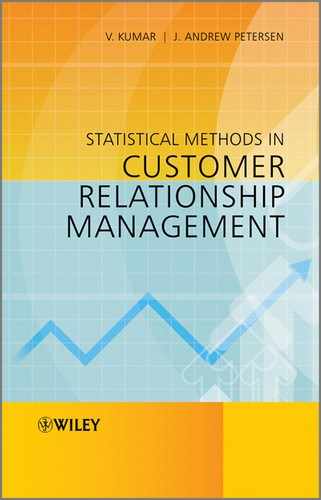Appendix F
Multinomial Logit Model
(Sources: Greene [1] and Borooah [2])
The unordered-choice model can be motivated by a random utility model. For the ![]() th customer faced with
th customer faced with ![]() choices, suppose that the utility of choice
choices, suppose that the utility of choice ![]() is
is
(F.1) ![]()
If the consumer makes choice ![]() , then we assume that
, then we assume that ![]() is the maximum among the
is the maximum among the ![]() utilities. Hence, the statistical model is driven by the probability that choice
utilities. Hence, the statistical model is driven by the probability that choice ![]() is made, which is
is made, which is
(F.2) 
McFadden [3] has shown that if and only if the ![]() disturbances are independent and identically distributed with Weibull distribution
disturbances are independent and identically distributed with Weibull distribution
(F.3) ![]()
then
(F.4) 
where ![]() is defined as a random variable that indicates the choice made. This is called the conditional logit model. The explanatory variables include two groups of factors, individual- and choice-specific attributes. Let
is defined as a random variable that indicates the choice made. This is called the conditional logit model. The explanatory variables include two groups of factors, individual- and choice-specific attributes. Let ![]() . The components of
. The components of ![]() are typically called the attributes of the choices and
are typically called the attributes of the choices and ![]() contain the characteristics of the individual. The multinomial model is the one that incorporates only individual characteristic effects, so that for such models all the
contain the characteristics of the individual. The multinomial model is the one that incorporates only individual characteristic effects, so that for such models all the ![]() .
.
In the multinomial logit model, the probabilities are
(F.5) 
(F.6) ![]()
The model implies that we can compute ![]() log-odds ratios
log-odds ratios
(F.7) ![]()
(F.8) ![]()
The multinomial logit model is estimated by the maximum likelihood estimation method. The log-likelihood can be derived by defining, for each individual, ![]() if alternative
if alternative ![]() is chosen by individual
is chosen by individual ![]() , and 0 if not, for the
, and 0 if not, for the ![]() possible outcomes. Then, for each
possible outcomes. Then, for each ![]() , one and only one of the
, one and only one of the ![]() is 1. The log-likelihood is a generation of that for the binomial probit or logit model:
is 1. The log-likelihood is a generation of that for the binomial probit or logit model:
(F.9) ![]()
The derivatives have the characteristically simple form
(F.10) ![]()
The exact second derivatives matrix has ![]() blocks,
blocks,
(F.11) ![]()
where ![]() equals 1 if
equals 1 if ![]() equals
equals ![]() , and 0 if not.
, and 0 if not.
